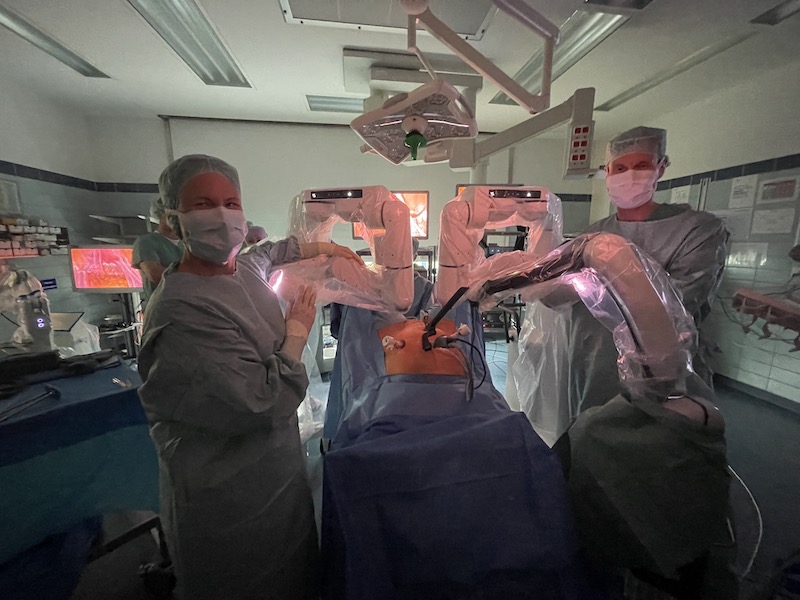University Hospital Tübingen carries out first Dexter robotic surgeries in Germany
University Hospital Tübingen has successfully completed gynecological operations using the Distalmotion Dexter on-demand robotic surgery system.
This marks the Swiss robot’s first clinical use in Germany.
Professor Dr Diethelm Wallwiener, Prof Dr Sara Brucker, Prof Dr Bernhard Krämer and their teams used the Dexter robot in several surgical procedures.
Cases where the surgeons drew on robotic assistance from Dexter included the removal of an ovarian cyst (cyst extirpation), the removal of an ovarian tumor (adnexectomy) and the removal of a patient’s uterus (hysterectomy).
These surgical procedures have in common that they entail complex work steps where utmost precision and care are required.

When removing an ovarian tumor, for example, surgeons must take extreme care to avoid rupturing the tumor, yet also ensure all cancerous cells are removed, and all this must be achieved without damaging the surrounding healthy anatomy.
In surgical jargon this sort of work step dealing with the delicate removal of adversely affected tissue is referred to as resection.
Resection and other complex surgical work steps like dissection, happening around delicate areas of the anatomy such as the ureter or vessels, require the utmost accuracy and control.
Robotic aid is a supplement in “keyhole surgery“ and a surgical robot is most useful for tasks like dissection and resection that require the highest degree of dexterity and precision.
Prof Wallwiener, Prof Brucker and Prof Krämer’s teams drew on the Dexter robot for these types of tasks.
The extent to which a surgical robot can contribute to optimizing procedure workflows and outcomes needs to be investigated further.
To address this the team in Tübingen will carry out a clinical study in cooperation with Distalmotion, the developer and manufacturer of the Dexter robot.
Robotic aid can be very beneficial in minimally invasive surgery. Yet only a fraction of hospitals can afford and sustain the investment in a surgical robot.
The Dexter robot was designed and developed to address this fundamental challenge for healthcare systems worldwide.
Dexter proposes a new approach, tailored to surgeons’ needs, reducing complexity, and making robotics more accessible.
The associated concept is called on-demand robotics and is based on the principle of flexibly catering to surgeons’ specific preferences and requirements in the OR.
The robot, all its instruments and all accessories are manufactured in Switzerland by a company called Distalmotion.
On-demand robotics has recently been adopted in select European countries. First in Switzerland, then in France and now the University Hospital Tübingen’s Department for Women’s Health and Gynecology has become the first German OR team to investigate and deploy the concept.
Prof Wallwiener says: “On-demand robotics is different by design. It is not so much about a new piece of technology, as it is a new mindset for robotic surgery.”
“The underlying design hypothesis is that we surgeons like to be in total control of the OR at all times, and that we would like to be able to choose and employ the tools and techniques that we deem best for our patient in every step of a procedure.”
Commenting on the relevance of the underlying design thinking, Prof Wallwiener says “someone read the surgeon’s mind.”
He adds: “Following early tests and exploration, we have now conducted first formal investigations to confirm whether this new concept can deliver on its promise.”
“Every patient and every case is different. As surgeons we navigate a great deal of uncertainty in the OR, while having to deal with significant pressure and responsibility, including making vital decisions affecting the quality of life of our patient.
“Confirming the extent and scenarios in which on-demand robotics gives us additional flexibility, control and security requires substantial clinical experience with the concept. We are mapping out the path to further bolster our investigation with additional clinical evidence.”
Prof Brucker says: “Our first experiences indicate that on-demand robotics redefines the relationship between surgeon and robot. The concept simplifies robotics, to make it user-friendly and to give us total control of the OR.
“The idea may seem obvious and simple, but the proverb ‘simplification is the ultimate sophistication’ applies when dealing with the complexities of laparoscopic surgery and robotics.”
She adds: “We are keen to contribute further towards the evaluation and development of guidelines for deploying on- demand robotics in gynecologic surgery.”
Based on his first surgeries with Dexter, Prof Krämer summarizes: “On-demand robotics gives us direct access to our patient and all surgical instruments – at all times. These benefits are new to robotic surgery.
“Initial experience suggests that this new freedom of choice can weigh strongly in empowering surgeons across a variety of indications and case-types. At the University Hospital Tübingen’s Department for Women’s Health and Gynecology we embrace our role as care providers, educators and researchers.
“We see an opportunity for on-demand robotics to make an impact in advancing all of said pillars in our mission statement and we are working out next steps to pursue this cause.”
Michael Friedrich, the company’s CEO, says: “A surgical robot is not always the surgeon’s best helper. Sometimes other tools and techniques are preferable.
“When the robot is needed, Dexter is available on-demand, quick and easy for surgeons to setup and operate. Surgeons can operate from the robotic console whenever they deem robotics their best helper for the given patient and procedure, that can be intermittently by leveraging ‘the switch’ between modalities, or it can mean employing the benefits of robotics more extensively, non-stop even.
“That is the essence of on-demand robotics, and we are excited to see this paradigm shift in robotic surgery gain traction in Germany now too.
“We are convinced that Dexter can make a difference for all hospitals, surgeons and patients who seek best-in-class minimally invasive treatment for gynecological, urological and gastrointestinal diseases.”

